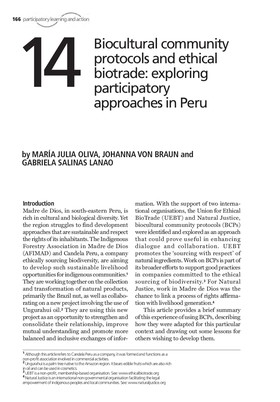Biocultural community protocols and ethical biotrade: exploring participatory approaches in Peru (PLA 65)

This article describes a ‘biocultural dialogue’ – a more focused BCP adapted to the context of ethical biotrade. It was developed by a local indigenous forestry organisation, AFIMAD, and a company~engaged in sourcing biodiversity ethically, Candela Peru. Developing a BCP was seen as a way to support the indigenous communities in advancing their social, cultural and environmental expectations of their commercial relationships. The development of the BCP involved an internal reflection process with representatives from the community. They considered how protocols could help them to better respond to commercial proposals concerning forest resources, increase the government’s recognition of their rights as indigenous communities, and communicate their views to other institutions and organisations. Beyond the document itself, which is still being discussed by the wider community, the~process helped AFIMAD reflect on its goals and values, as well as its economic activities, and reaffirmed its significance within the communities. As a result, it was able to communicate in subsequent dialogue with Candela Peru much more assertively on issues such as sustainable resource use, negotiation processes, the kind of relationship they wanted, and the sharing of benefits. The communities and Candela Peru are now better placed to understand and address each other’s needs and concerns in the context of their current and future work.
This article appears in Participatory Learning and Action 65 on Biodiversity and culture: exploring community protocols, rights and consent.
Cite this publication
Available at https://www.iied.org/g03409